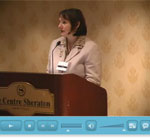Montreal Job Search Strategies Forum Report
The Transition from School to Work
| Video |
 |
Daria Kowalyk, BMO
Daria Kowalyk shared some career-planning tips.
Managing the transition from school to work takes a lot of resiliency. It involves managing change, studying career options, cultivating inner resources, learning continuously, building and sustaining relationships through networking, understanding self-worth, nurturing inner well-being, and creating a support network.
Kowalyk provided four steps in creating a career plan. The first step is a self-assessment assembled with input from friends, colleagues and peers. The second is defining career goals. Kowalyk described this as “an opportunity to listen, reflect, and pause before you act.” The third step is action planning: a process of summarizing ideas and strengths. The last step is finalizing the plan and acting on it.
Kowalyk defined self-assessment as “the process of gathering information about yourself in order to make informed career decisions.” This information should include values, interests, personality, and skills.
It should also be a time for job seekers to reflect on their stage of life. For example, is the job seeker thinking of starting a family? The answer will lead to further questions, such as, “What opportunities or constraints does this place on my short- and long-term career goals?”
Self-assessment requires job seekers to ask direct questions of themselves, and to ask others what they think of the job seeker. Kowalyk encouraged job seekers to take time to “process this feedback, and be honest with yourself about your weaknesses and your strengths.”
She showed a slide of a form used by BMO employees to explore their career plans. The top left-hand square addresses personal and professional goals. “What motivates me and drives me to achieve? What work do I enjoy most? What interests me?” What kind of work am I most passionate about?”
The second set of questions examines personal values: “What is important to me? What are my needs and priorities? Where am I in my life stages? What are my strengths and capabilities? What do my personal and professional mentors say are my greatest strengths?”
The next section of the form focuses on areas requiring development. “Where can I improve? What would my mentors say are my greatest opportunities for improvement?”
Kowalyk said answering these questions would provide job seekers with a lot of information about themselves. With that information collected, job seekers can begin to think about their professional brand.
Kowalyk explained the concept of branding. She said that just as certain words come to mind when a popular commercial brand is mentioned, some adjectives or ideas surface when thinking about an important person in one’s life. She asked that participants take 10 seconds to reflect on what perceptions people have about them. “What do you think others say about you? That is your brand. Your professional brand is the collection of perceptions that others hold about you, including your skills and how others feel about you.”
A professional brand consists of everything from body language to word choice and tone of voice. “They convey competence, skill, whether you are trustworthy, how you work with others, your values, and what kind of work you deliver,” said Kowalyk.
When defining a professional brand, job searchers should ask, “How do I present myself to others? Do I present my ideas and work with confidence? Do I speak too softly? Do I get defensive when someone disagrees with me? Am I pleasant? How do others perceive me? Do they seek out my company? Do they ask for my advice? How well do I build relationships? How do I connect with people? In my best interactions, how did I engage with others?”
Job seekers should use the answers to these questions to improve the way they interact with others. Kowalyk encouraged job seekers to consider what their peers would say were their biggest opportunities for improvement.
The next stage, defining career goals, requires job seekers to reflect on what they hope to achieve in the next five years. In this stage, too, Kowalyk advised reaching out to mentors for advice.
“It will probably take a lot of courage to accept feedback, meet people, and ask for help. Don’t be afraid to reach out to a possible mentor. Mentors will encourage you to step out of your comfort zone.” This is a long-term process, she cautioned, one that cannot happen instantaneously. “This takes a lot of perseverance.”
Career goals may be discovered through answering three questions: Does the job seeker want to work for a specific company? Is the job seeker focused on achieving a specific designation, role, community, or type of work? How important is the workplace’s culture to the job seeker?
The action-planning stage involves defining and committing to a plan that could include networking, information interviews, job shadowing, or volunteering. At this point, job seekers must determine which experiences will provide the best opportunities for developing networks and skills. It is also a time to look for any needed support—the tools, resources, and feedback that will help job seekers attain their goals.
All the work done in the previous stages—creating a professional brand, identifying strengths and opportunities for development, and defining career goals—is brought together in the final plan of action.
Kowalyk summarized the individual’s role in this process:
- Know yourself.
- Identify your goals and skills.
- Focus on what makes you unique.
- Understand the current employment environment.
- Network and sustain mentoring relationships.
- Know the issues, challenges, and objectives of the business you want to work for.
- Create and commit to an action plan based on specific, obtainable career goals.

 Quick Question:
Quick Question:

